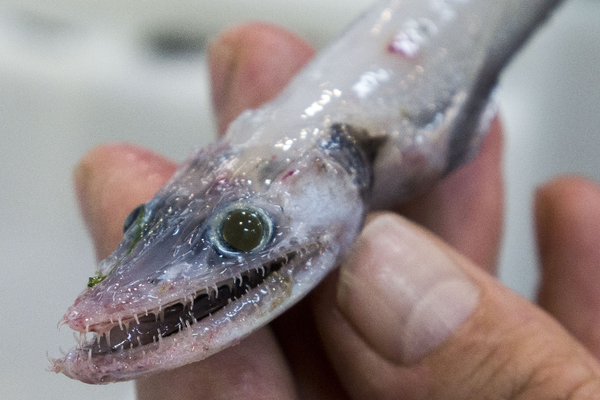The World’s Deepest-Living Fish Is Surprisingly Cute
Meet the Mariana snailfish, the top dog at the bottom of the world.

The Mariana Trench—the deepest place in the world, located a few hundred miles off the coast of Guam—is full of mysteries: ghostly clams, huge single-celled creatures, bubbles of liquid carbon dioxide. Thanks to an international group of oceanographers, we now know who’s at the top of the bottom: the Mariana snailfish, or Pseudoliparis swirei. The four-inch creature appears to be the chief predator in certain zones of the Trench, and has also been videotaped at around 8,000 meters below sea level, making it the farthest-down fish known to exist.
The snailfish family is widespread and diverse, with different species found everywhere from the kelp forests of the Bering Strait to inside the shells of North Atlantic scallops. “We’ve known there were snailfish living in a few other trenches,” says Mackenzie Gerringer, a member of the research team that discovered the fish, and the lead author of a paper describing the new species, recently published in Zootaxa. “But there had never been a fish caught in the Mariana Trench.”

To reel things in from deep down, the team, working from the R/V Falkor, used special weighted traps that sank to the bottom over hours. After a day or so on the floor, the team sent acoustic signals to the traps, which then released their weights and rose to the surface.
Over two trips in 2014 and 2017, the team caught 37 snailfish. When they retrieved them from the floating traps, they knew they had nabbed something special. “When we looked closer at the morphology and the DNA, we found that it was a new species,” Gerringer says.
They also saw that their catch bucked some stereotypes. “They look pretty different from what the public [expects] a deep-sea fish to look like,” says Gerringer. “We often think of the anglerfish, or something else with big teeth.” The snailfish, instead, are “kind of small and pink and cuddly-looking.” In photos, they’re more Seussian than scary, with long pointy tails and nearly translucent skin.
But appearances can be deceiving. In video footage from the Trench, the Mariana snailfish swarm around a camera trap, chomping on small arthropods attracted to the bait within. When Gerringer dissected her samples, she found hundreds of these little guys in the fishes’ stomachs, along with larger gobbled-up crustaceans. “[Mariana snailfish] are the top predators that we know of in the zone,” she says.
They’re also tough in ways we fragile humans can’t imagine. Creatures living at 8,000 meters below sea level are subject to about 11,680 pounds of pressure per square inch, which is roughly equivalent to having Michelangelo’s David step on your toe.

While it’s unclear exactly how the fish handle this, Gerringer says the researchers have begun pinpointing stabilizing molecules and specially adapted enzymes that might help. “We’re trying to piece together more than just the name and the morphology, but also who they are and how they’re living down there,” she says.
In the meantime, the team chose the fish’s scientific name in order to honor some humans who are great under pressure. “There are all these crew members that keep the ship running, and keep everyone safe and fed and happy,” says Gerringer. “We wanted to thank them.” And so the “swirei” in P. swirei is for Herbert Swire, the First Navigating Sublieutenant of the HMS Challenger. The Challenger became the first ship to sound the Mariana Trench in the 1870s, setting the stage for centuries of oceanography—including, eventually, the discovery of this strange, deep fish.












Follow us on Twitter to get the latest on the world's hidden wonders.
Like us on Facebook to get the latest on the world's hidden wonders.
Follow us on Twitter Like us on Facebook